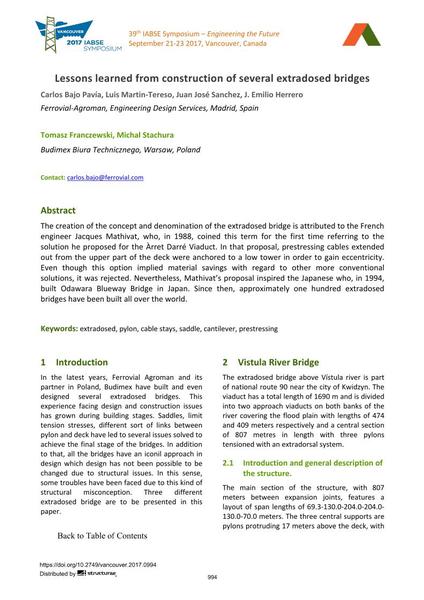Lessons learned from construction of several extradosed bridges

|
|
|||||||||||
Détails bibliographiques
| Auteur(s): |
Carlos Bajo Pavía
(Ferrovial-Agroman, Engineering Design Services, Madrid, Spain)
Luis Martín-Tereso Juan José Sánchez J. Emilio Herrero (Ferrovial-Agroman, Engineering Design Services, Madrid, Spain) Tomasz Franczewski (Budimex Biura Technicznego, Warsaw, Poland) Michal Stachura (Budimex Biura Technicznego, Warsaw, Poland) |
||||
|---|---|---|---|---|---|
| Médium: | papier de conférence | ||||
| Langue(s): | anglais | ||||
| Conférence: | IABSE Symposium: Engineering the Future, Vancouver, Canada, 21-23 September 2017 | ||||
| Publié dans: | IABSE Symposium Vancouver 2017 | ||||
|
|||||
| Page(s): | 994-1001 | ||||
| Nombre total de pages (du PDF): | 8 | ||||
| Année: | 2017 | ||||
| DOI: | 10.2749/vancouver.2017.0994 | ||||
| Abstrait: |
The creation of the concept and denomination of the extradosed bridge is attributed to the French engineer Jacques Mathivat, who, in 1988, coined this term for the first time referring to the solution he proposed for the Àrret Darré Viaduct. In that proposal, prestressing cables extended out from the upper part of the deck were anchored to a low tower in order to gain eccentricity. Even though this option implied material savings with regard to other more conventional solutions, it was rejected. Nevertheless, Mathivat’s proposal inspired the Japanese who, in 1994, built Odawara Blueway Bridge in Japan. Since then, approximately one hundred extradosed bridges have been built all over the world. |
||||
| Mots-clé: |
pylône extradossé
|
||||

